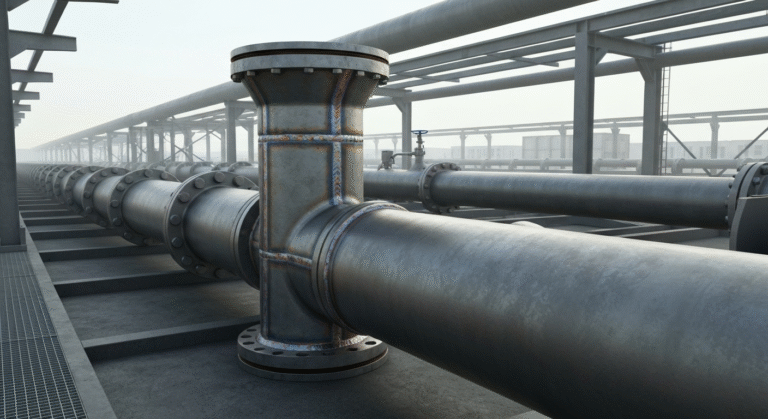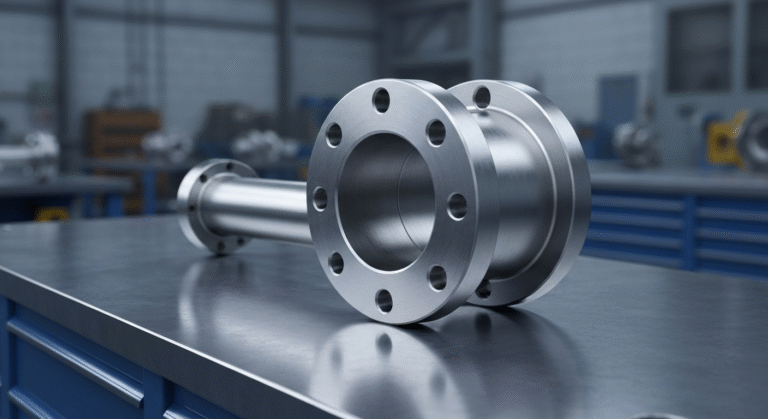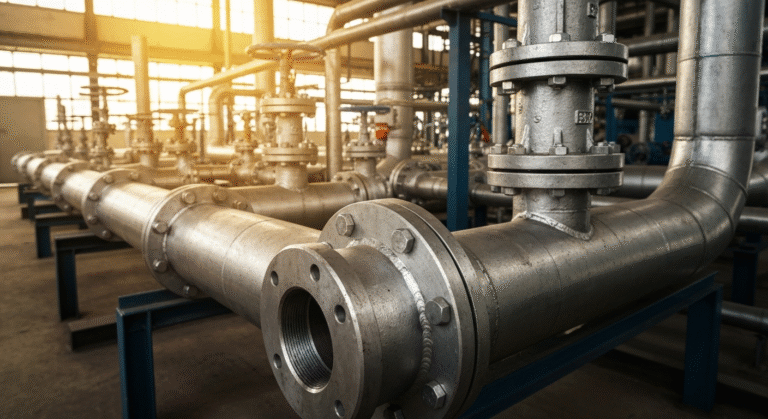-
中国河北省滄州市孟村県銀庄工業区
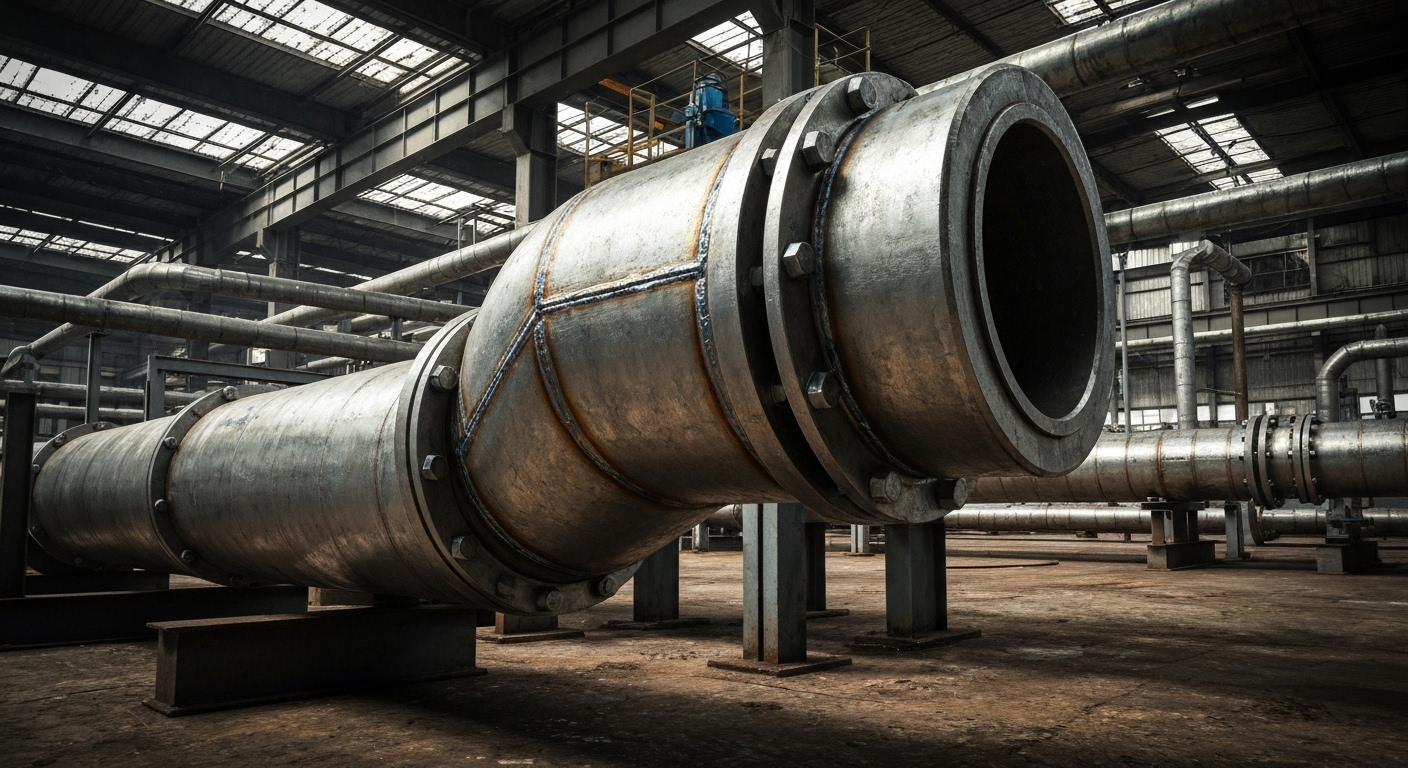
Essential Features of Carbon Steel Elbow for Weld Fittings
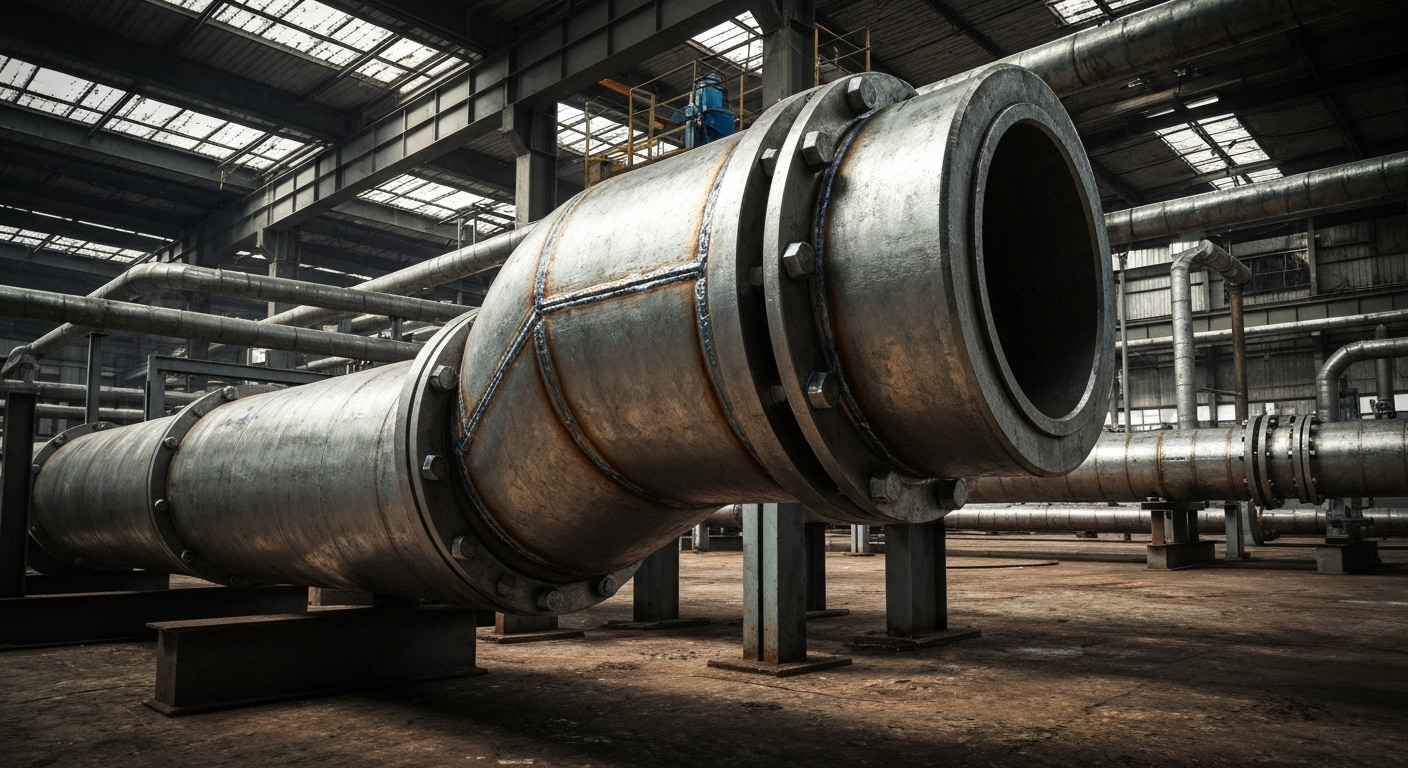
主なハイライト
- A carbon steel elbow is a crucial pipe fitting used to change the direction of flow in a piping system.
- These fittings are vital for connecting a steel pipe of the same or different nominal diameter.
- Common angles include 45°, 90°, and 180°, each serving a specific purpose in fluid direction.
- The primary types are defined by radius (long or short) and connection style (butt weld, socket weld, or threaded).
- Carbon steel offers strength and durability, making it ideal for high-pressure and high-temperature applications.
- Understanding material grades and standards like ASTM A234 WPB ensures you select the right component.
はじめに
Welcome to our guide on carbon steel elbows! If you work with any kind of piping, you know how important it is to guide the flow of liquids or gases effectively. A steel pipe elbow is one of the most fundamental pipe fittings for this job. Made from durable carbon steel, these components are designed to connect two pipes and change the direction of the pipeline. This article will walk you through the essential features you need to know about these indispensable fittings.
Key Applications of Carbon Steel Elbows in Piping Systems
Carbon steel elbows are workhorses in a vast range of industrial applications. Their primary function is to change the direction of a piping system, making them essential for navigating corners and obstacles. You’ll find these durable steel pipe fittings in everything from simple water lines to complex chemical processing plants.
Their strength and reliability make the carbon steel elbow a go-to choice for critical infrastructure, including oil and gas pipelines. Whether you’re dealing with low-pressure water flow or high-pressure gas transport, there’s a carbon steel elbow designed for the job. We’ll explore some of these specific uses in more detail.
Industrial Uses in Oil, Gas, and Water Lines
In the oil industry, pipeline systems often need to cover long distances and navigate complex terrains. A carbon steel elbow is essential for making these directional changes safely and efficiently. Its robust construction ensures that it can handle the pressures associated with transporting crude oil and other petroleum products without failure.
Similarly, gas pipelines rely heavily on these fittings. When constructing networks that supply natural gas to homes and businesses, engineers use carbon steel elbows to route the steel pipe around structures and through varied landscapes. Their durability is critical for maintaining the integrity of these high-stakes systems.
Beyond fossil fuels, you will find these elbows in water lines and chemical pipelines. From municipal water supply facilities to industrial plants handling corrosive materials, the strength of carbon steel makes it a dependable choice for ensuring a secure and leak-free connection.
Role in High-Pressure and Temperature Environments
Have you ever wondered what makes carbon steel elbows so suitable for demanding jobs? Their ability to perform in high-pressure and high-temperature environments is a key reason. Carbon steel, an alloy of iron and carbon, possesses inherent strength that allows it to withstand significant internal force, making it perfect for high-pressure pipeline applications.
This resilience is especially important in sectors like power generation, where steam and other hot fluids are transported through a steel pipe network. The material can maintain its structural integrity even when exposed to elevated temperatures, preventing costly and dangerous system failures. Different elbows come with specific pressure ratings to match the demands of the job.
Because of this toughness, carbon steel fittings are a top choice for many industrial applications that operate in harsh environments. Whether it’s a chemical plant or an offshore oil rig, these elbows provide the reliability needed to keep operations running smoothly and safely under stress.
Types of Carbon Steel Elbows for Weld Fittings
Not all carbon steel elbows are the same. They come in several variations to meet the specific needs of a project. The main distinctions are based on the elbow’s radius and angle. The radius determines how sharp or gradual the turn is, which affects fluid flow and pressure.
You’ll primarily encounter long radius (LR) and short radius (SR) elbows. The choice between them depends on the available space and the requirements of your piping system. Additionally, elbows come in different angles, such as a 45 or 90-degree elbow, to achieve the desired change in direction. Let’s look at these types of steel pipe fittings more closely.
ロング・ラジアス・エルボーとショート・ラジアス・エルボー
When choosing a steel pipe elbow, one of the first decisions you’ll make is whether to use a long radius (LR) or short radius (SR) type. The main difference is the curvature. A long radius elbow has a curve radius that is 1.5 times the pipe’s nominal diameter, creating a gentler turn. This is the standard choice for most pipeline systems as it minimizes friction and pressure drop, making it ideal for high-flow-rate applications.
A short radius elbow, on the other hand, has a radius equal to the pipe’s nominal diameter. This results in a much sharper turn. SR elbows are typically used in tight spaces where a gradual bend isn’t possible. They are more common in low-pressure and low-speed pipeline systems.
Understanding these direction changes is key to designing an efficient system. When you need smooth flow, a long radius 90-degree steel pipe elbow is your best bet. If space is your primary constraint, a short radius elbow will get the job done.
特徴 | ロングラジアス(LR)エルボー | ショートラジアス(SR)エルボー |
|---|---|---|
Radius | 1.5 times the pipe diameter | Equal to the pipe diameter |
Turn | Gradual and smooth | Sharp and tight |
Friction | より低い | より高い |
圧力降下 | Minimal | More significant |
一般的な使用 | High-pressure, high-velocity flow | Low-pressure, low-velocity flow; tight spaces |
Common Angle Options: 45°, 90°, and 180°
Beyond the radius, elbow fittings are categorized by their angle, which dictates the change in fluid direction. The most common types are designed to handle standard directional changes in a piping system. Your project’s specific needs will determine which degree elbow is the right fit.
The three main angles you’ll work with are 45°, 90°, and 180°. Each one serves a distinct purpose, from making slight adjustments to completely reversing the flow. There are also other angles like 60° available for more specialized pipeline designs.
Here’s a quick breakdown of the most common options:
- 90° Elbow: Also known as a “vertical elbow,” this is the most widely used type. It creates a sharp, right-angle turn and is a staple in steel construction.
- 45°エルボ: This elbow creates a gentler turn, resulting in less friction and pressure loss compared to a 90° elbow.
- 180° Elbow: This fitting, also called a “return bend,” reverses the direction of flow by 180 degrees. It is often used in heating coils and heat exchangers.
Material Grades and Standards for Carbon Steel Weld Elbows
When you select a carbon steel weld elbow, it’s not just about size and angle. The material grade is a critical factor that ensures the fitting can handle the intended application. Industry standards, such as those set by ASTM International, provide specifications for chemical composition and mechanical properties, guaranteeing performance and safety.
These standards help you differentiate between various types of steel, including carbon steel, alloy steel, and stainless steel. For steel pipe fittings, adhering to these recognized material grades is essential for reliability and compliance. We will now examine some of the most important standards you should know.
Importance of ASTM A234 WPB Elbow Specification
If you work with carbon steel fittings, you will frequently encounter the ASTM A234 WPB specification. This is one of the most common industry standards for carbon steel pipe fittings intended for moderate and high-temperature service. The “WPB” designation stands for “weldable, pressure, grade B,” indicating its suitability for pressure piping systems.
This standard covers wrought carbon steel and alloy steel fittings of seamless and welded construction. When you see a fitting marked with ASTM A234 WPB, you can be confident that it meets specific requirements for tensile strength, chemical composition, and manufacturing processes. This makes it a reliable choice for general-purpose steel construction and industrial piping.
Using fittings that comply with ASTM A234 WPB ensures compatibility and safety within your system. It simplifies the selection process and guarantees that the carbon steel pipe components you use are designed to perform under pressure, making it a cornerstone of quality pipeline projects.
Other Essential Material Grades and Their Uses
While straight carbon steel is a popular choice, some applications demand different properties. This is where other material grades, like alloy steel and stainless steel, come into play. These materials are created through specific production processes that introduce other elements to enhance certain characteristics.
Alloy steel contains additional elements like manganese, nickel, or chromium, which improve its hardness, strength, or chemical resistance. These pipe fittings are often used in more specialized, high-stress environments where standard carbon steel might not suffice. Their lower plasticity is offset by superior durability under extreme conditions.
Stainless steel offers excellent corrosion resistance due to a higher chromium content. This makes it the preferred material for applications involving corrosive fluids or where hygiene is paramount, such as in food processing or chemical plants. While more expensive, its longevity and resistance to rust can make it a cost-effective choice in the long run.
Selecting the Right Carbon Steel Elbow Size and Schedule
Choosing the correct carbon steel elbow involves more than just the angle and radius. You also need to consider the pipe size and schedule. The size must match the nominal diameter of the steel pipe you are connecting to ensure a proper fit. The schedule, on the other hand, refers to the wall thickness of the fitting.
This is a critical detail, as the wall thickness directly impacts the elbow’s strength and its pressure ratings. A thicker wall can withstand higher internal pressures. Matching the elbow’s schedule to the rest of your piping system is essential for maintaining consistent performance and safety.
What Sch 40 Means for Weld Fittings
When you look at specifications for steel pipe fittings, you’ll often see terms like “Sch 40” or “Schedule 40.” This designation refers to the wall thickness of a pipe or fitting. The schedule number is a standardized way to define how thick the walls are relative to the pipe size. A higher schedule number means a thicker wall.
For a steel pipe elbow, Sch 40 is a very common and versatile standard. It offers a good balance of strength, weight, and cost, making it suitable for a wide range of applications that don’t involve extremely high pressure. It can handle moderate pressures reliably without the extra weight and expense of thicker-walled fittings.
Choosing a Sch 40 fitting ensures it can withstand the operational pressures of many standard systems. While it may not be sufficient for applications requiring resistance to higher pressure, it is the go-to choice for general plumbing, water lines, and many industrial processes where it effectively minimizes pressure loss.
Sizing and Measurement Tips for Seamless Elbow and Butt Weld Elbow
Accurate measurement is crucial when selecting a seamless elbow or a butt weld elbow. An incorrect size can lead to installation problems and potential leaks. The first step is to confirm the nominal pipe size (NPS) of the pipes you are connecting. Fittings are designed to match these standard dimensions.
When dealing with different nominal diameters, you might need a reducer elbow, which transitions from one pipe size to another. The connection type also matters; a butt weld elbow is designed to be welded directly end-to-end with the pipe, so the inner and outer diameters must align perfectly.
Before you order, double-check your measurements. Here are a few tips:
- Confirm the Nominal Pipe Size (NPS) of your pipes.
- Measure the outside diameter (OD) to verify the pipe size.
- Check the schedule (wall thickness) to ensure it matches your system’s requirements.
- Specify the angle (e.g., 90°, 45°) and radius (LR or SR) needed for the connection.
Installation Practices for Carbon Steel Weld Elbows
Proper installation is key to getting the most out of your carbon steel weld elbows. Since these pipe fittings are designed for welding, the quality of the weld is paramount to the integrity of the entire piping system. An improper welding process can create weak points that may lead to leaks or failures down the line.
The goal of installation is to create a strong, seamless connection between the elbow and the steel pipe. This ensures that the joint is as strong as the pipe itself. To achieve this, it’s important to follow best practices for the specific type of weld fitting you are using. Let’s review some common approaches.
Best Approaches for Butt Weld Installation
A butt weld connection is the strongest and most reliable method for joining a steel pipe elbow to a pipe. This welding process involves aligning the beveled ends of the elbow and pipe and fusing them together. The result is a continuous metal structure that offers exceptional high strength and durability.
The primary advantage of a butt weld is superior leak prevention. Because the joint becomes part of the pipe itself, there are no gaskets or threaded connections that could degrade over time. This makes it the preferred method for high-pressure and high-temperature systems where failure is not an option.
To ensure a successful installation, follow these key steps:
- Preparation: Clean the beveled ends of both the pipe and the elbow to remove any dirt, oil, or rust.
- Alignment: Carefully align the two pieces, ensuring a consistent gap for the weld material.
- Welding: Use the appropriate welding process and filler material for carbon steel.
- Inspection: After welding, inspect the joint for any defects to ensure a solid, leak-proof seal.
Steps for Installing Seamless Carbon Steel Elbows
Installing a seamless elbow follows a similar process to other butt weld fittings, as they are typically joined using a butt weld. A seamless elbow is manufactured from a single piece of seamless pipe, which means it has no welded seams of its own, offering uniform strength and structure. This makes it an excellent choice for high-pressure applications.
Before installation, a general surface treatment is recommended. This involves cleaning the ends to be welded to ensure they are free of contaminants that could compromise the weld. A clean surface is essential for creating a strong, permanent bond between the steel pipe fittings and the pipe.
Whether for a new installation or a pipeline repair project, these steps will help ensure a secure connection:
- Prepare Surfaces: Thoroughly clean the ends of the seamless elbow and the connecting pipe.
- Align Components: Position the elbow and pipe, ensuring perfect alignment and a consistent root gap.
- Tack Weld: Apply small tack welds to hold the components in place before completing the full weld.
- Complete the Weld: Execute the final weld around the entire circumference of the joint, ensuring full penetration.
Benefits of Using Butt Weld Carbon Steel Elbows
Why choose a butt weld carbon steel elbow for your piping system? The benefits are significant, especially for demanding applications. This connection type creates a joint that is as strong as the pipe itself, offering higher strength and unmatched reliability compared to threaded or socket weld fittings.
This strong, continuous structure provides excellent leak prevention and minimizes turbulence, which reduces pressure loss in the system. When you need a permanent, robust solution for changing flow direction, the butt weld method is often the best choice. Let’s dig into these advantages a little more.
強化された強度と漏れ防止
The number one reason to use butt weld carbon steel fittings is their incredible strength. When an elbow is welded to a pipe, the joint essentially becomes a single, solid piece of metal. This continuous steel construction provides higher strength than mechanical connections, which can loosen over time due to vibration or pressure fluctuations.
This robust connection is also your best defense against leaks. With no threads or gaskets to fail, a properly executed butt weld offers superior leak prevention. This is critical in systems handling hazardous materials or operating under high internal pressure, where even a small leak could have serious consequences.
By creating a smooth inner surface, butt weld joints also reduce turbulence and erosion within the pipe. This not only improves flow efficiency but also extends the life of your entire pipeline, making it a smart investment for long-term reliability.
Cost-Efficiency and Longevity in Piping
While the initial installation of butt weld fittings may require skilled labor, their long-term cost-efficiency is a major benefit. Because these joints are so durable and resistant to leaks, they require less maintenance over the life of the piping system. This reduction in repair and replacement costs can lead to significant savings.
The longevity of a butt weld carbon steel elbow is another key advantage. These essential components are built to last, providing a permanent solution that you can rely on for years to come. When you use them to connect a steel pipe, you’re investing in the overall durability and integrity of your pipeline.
So, as you plan your next project, consider the total cost of ownership. The strength and reliability of butt weld elbows make them a smart, cost-effective choice that will contribute to a long-lasting and efficient piping system.
Quality Assurance and Certifications for Weld Fittings
When purchasing weld fittings, how can you be sure you’re getting a quality product? The answer lies in quality assurance and certification. Reputable manufacturers adhere to strict industry standards and conduct thorough testing procedures to verify the performance and safety of their products.
This commitment to quality ensures that the fittings you receive meet all required specifications for material composition, dimensional accuracy, and strength. Understanding these certifications is key to sourcing reliable components for your projects. We’ll cover the common tests and compliance requirements you should look for.
Common Testing Procedures and Certification Requirements
To guarantee quality, pipe fittings undergo a series of rigorous tests before they are certified for use. These testing procedures are defined by industry standards to ensure that every fitting meets the required performance criteria. This process is a fundamental part of quality assurance in manufacturing.
These tests can include chemical analysis to verify the material grade and mechanical tests to confirm properties like tensile strength and hardness. Dimensional checks are also performed to ensure the fitting will align correctly with the pipe. Only after passing these tests can a product receive certification.
Common procedures you might see on a certification document include:
- Tensile Test: Measures the fitting’s strength and ductility under tension.
- Hardness Test: Determines the material’s resistance to deformation.
- Hydrostatic Test: Checks for leaks by pressurizing the fitting with water.
- Visual and Dimensional Inspection: Ensures the fitting is free from defects and meets size specifications.
International Compliance for U.S. Applications
In a global marketplace, many pipe fittings are manufactured internationally. For them to be used in U.S. applications, they must demonstrate international compliance with U.S. standards. Organizations like ASTM and ASME set the benchmarks that are widely recognized and accepted across borders.
This means that a carbon steel elbow, which is an alloy of iron and carbon, manufactured in another country can be used in the United States as long as it carries the proper certification. The manufacturer must provide documentation proving that its quality assurance processes and final products meet the specifications laid out in standards like ASTM A234.
This system of international compliance ensures a consistent level of quality and safety, regardless of where the product was made. When you purchase fittings, always look for documentation that confirms adherence to relevant U.S. standards to ensure you are getting a reliable and compliant product.
Sourcing and Purchasing Carbon Steel Elbows Online
In today’s digital world, sourcing and purchasing carbon steel elbows online has become easier than ever. Many reputable online suppliers offer a wide range of steel pipe fittings, allowing you to compare products and prices from the comfort of your office. This convenience can save you time and help you find the exact components you need.
However, buying online requires careful attention to detail. It’s important to verify the supplier’s credibility and ensure the products meet your project’s specifications. Let’s go over what to check before you buy and where to find reliable suppliers.
Key Specifications to Check Before Buying
Before you click “purchase” on those steel pipe fittings, it’s vital to review the product specifications carefully. A small mistake in the details can lead to big problems on the job site. The first things to confirm are the basic dimensions: pipe size, schedule (wall thickness), angle, and radius.
Next, consider the performance requirements. Check the material grade to ensure it offers the right balance of strength and corrosion resistance for your application. You should also verify the pressure ratings to confirm the elbow can handle the operating conditions of your system.
Here is a quick checklist of specifications to review:
- Nominal Pipe Size (NPS) and Schedule: Ensure they match your existing pipeline.
- Angle and Radius: Select the correct degree (e.g., 90°) and radius (LR or SR).
- Material Grade: Confirm the material (e.g., ASTM A234 WPB) is appropriate.
- Standards and Certifications: Look for compliance with ASTM, ASME, or other relevant standards.
Top Suppliers for ASTM A234 WPB and Seamless Elbows in the U.S.
Finding reliable U.S. suppliers for carbon steel fittings is key to ensuring you receive high-quality, certified products. When searching for ASTM A234 WPB and seamless elbows, look for established distributors and manufacturers with a strong reputation in the industry. These suppliers typically offer comprehensive product catalogs and can provide the necessary documentation to prove compliance.
Many national and regional industrial supply companies stock a wide variety of fittings for any piping system. They often have experts on staff who can help you select the right components for your specific needs. Online industrial marketplaces are also a great resource, connecting you with numerous vendors.
When vetting a supplier, ask for material test reports (MTRs) and certifications. A trustworthy supplier will readily provide this information, giving you confidence that you are purchasing genuine, high-quality seamless elbows and other fittings that will perform as expected in your piping system.
結論
In summary, carbon steel elbows play a vital role in ensuring the efficiency and reliability of piping systems across various industries. Understanding their essential features, applications, and installation practices is crucial for achieving optimal performance. From selecting the right type and angle to adhering to industry standards and certifications, every detail matters in ensuring the longevity and safety of your piping infrastructure. Whether you’re involved in oil, gas, or water lines, mastering the nuances of carbon steel elbows will not only enhance your project outcomes but also contribute to cost efficiency. If you’re ready to make informed choices for your piping needs, explore our top suppliers for high-quality carbon steel elbows today!
よくある質問
Are carbon steel elbows suitable for high-pressure piping?
Yes, a carbon steel steel pipe elbow is very suitable for high-pressure piping. Its inherent strength allows it to withstand significant internal forces. By selecting an elbow with the appropriate wall thickness (schedule) and pressure ratings, you can ensure it performs safely and reliably in a high-pressure piping system.
How do you differentiate between seamless elbow and butt weld elbow?
A seamless elbow is defined by its manufacturing process—it’s made from a single piece of pipe with no welded seams. A butt weld elbow refers to the connection type, where the fitting is welded end-to-end with the pipe. Most seamless steel pipe fittings are designed as butt weld elbows.
What should you look for when choosing the correct carbon steel elbow for your application?
When choosing a carbon steel elbow, check the pipe size (NPS), wall thickness (schedule), and angle (degree elbow). Also, consider the radius (LR or SR) for flow efficiency and the material grade to ensure it meets your strength and corrosion resistance needs. Matching these to your system is crucial.
